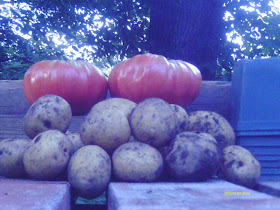Hi its me Farm Girl and once again I have to help save certain elements among our readership from their own self destructive tendencies. Folks, its about blackberries.
 No, not this no doubt fascinating and apparently useful device. We have nothing to say about this at all.
No, not this no doubt fascinating and apparently useful device. We have nothing to say about this at all.
We refer to the yumptious, scrumptious blackberry found on bushes in the countryside and which make such delicious snacks, pies* and ice creams. This is a BLACK BERRY. It is OK and in fact commendable to pluck them.
 This, however, is a Black Beary, and a wise and rational human being will leave him forever unplucked.
This, however, is a Black Beary, and a wise and rational human being will leave him forever unplucked.
"Why, Farm Girl, do you raise this as an issue?"
Well, you see what our friend Mr. Ursus americanus is doing, do you not? He is packing his bear mug with delicious black berries. He likes them as much as we do. In fact, he likes them so much that he feels that they belong to him.
 When, as inevitably happens each summer, one berry picker...
When, as inevitably happens each summer, one berry picker...
 Blunders into another berry picker, then bad things are apt to happen...
Blunders into another berry picker, then bad things are apt to happen...
These bad things almost never happen to the bear.
 Witness this unfortunate and not especially happy lady, Canadian Katy Lin. In Ms. Lin's case the dispute was not over berries, but rather over who was going to be allowed to play in Ms. Lins garden.
Witness this unfortunate and not especially happy lady, Canadian Katy Lin. In Ms. Lin's case the dispute was not over berries, but rather over who was going to be allowed to play in Ms. Lins garden.
The point is, be aware of where you are. If it is bear country - and most of the United states and Canada is exactly that - be aware of your surroundings. Remember that when you are picking berries you are raiding the bear's pantry, at least as far as the bear is concerned.
While black bears are "cute" in some peoples eyes, and appear lovable and cuddly, they are not. A bear is always a bear.
The also have an undeserved reputation for timidity. No, they are not as dangerous as a polar bear or grizzly and many times they will avoid a confrontation with a human. But not always.
Don't be the newspaper article of the day! Make noise while berry picking so you don't startle a bear. If you see one, back away, slowly.
If local laws permit it, take a firearm along.
And if you make a pie, save a slice for me!
You might also wish to check out this tale by Mike Logan, who has had his own ursine encounters. It appears on Saturday Sunshine and can be accessed right HERE:
That is about all that this topic will bear, so as always, thanks for stopping by at Farm Girls Corner!
**************************************************************
*Woops! Nearly forgot the pies!
Human berry pickers often make juicy delicious pies, bursting with berries and a crisp and tasty crust.
Bears generally eschew the crust.



































